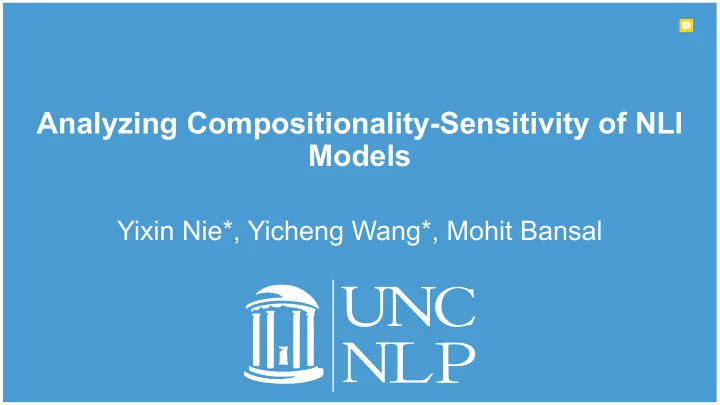

Analyzing Compositionality-Sensitivity of NLI Models Yixin Nie*, Yicheng Wang*, Mohit Bansal
Natural Language Inference (Premise, Hypothesis) à Label { Entailment, Contradiction, Neutral } 2
Importance of NLI The concepts of entailment and contradiction are central to all aspects of natural language meaning. Thus, natural language inference (NLI) — characterizing and using these relations in computational systems is essential in many NLP tasks such as question answerin g and summarization . Success in natural language inference (NLI) intuitively requires a model to understand both lexical and compositional semantics. 3
Importance of NLI The concepts of entailment and contradiction are central to all aspects of natural language meaning. Building computation systems that can recognize these relationships is essential to many NLP tasks such as question answerin g and summarization . Success in natural language inference (NLI) intuitively requires a model to understand both lexical and compositional semantics. 4
Difficulty of NLI At a high level, NLI is a complicated task with many components. Intuitively, success in natural language inference needs a certain degree of sentence-level understanding . Sentence-level understanding requires a model to capture both lexical and compositional semantics. Success in natural language inference (NLI) intuitively requires a model to understand both lexical and compositional semantics. 5
Difficulty of NLI At a high level, NLI is a complicated task with many components. Intuitively, success in natural language inference needs a high degree of sentence-level understanding . Sentence-level understanding requires a model to capture both lexical and compositional semantics. Success in natural language inference (NLI) intuitively requires a model to understand both lexical and compositional semantics. 6
Difficulty of NLI At a high level, NLI is a complicated task with many components. Intuitively, success in natural language inference needs a high degree of sentence-level understanding . Sentence-level understanding requires a model to capture both lexical and compositional semantics. Success in natural language inference (NLI) intuitively requires a model to understand both lexical and compositional semantics. 7
Datasets • Stanford Natural Language Inference (SNLI) 570k pairs (image caption genre) • Multi-Genre Natural Language Inference (MNLI) 433k pairs (multiple genres e.g. news, fiction) 8
Models premise hypothesis Neural Network Model Trained on provided training set. predicted label 9
Current Model and Motivation SNLI leaderboard Despite their high performance, it is unclear if models employ semantic understanding or are simply performing shallow pattern matching. Counterintuitive model designs indicate an over- focus on lexical information, which is different from human reasoning. This motivates our analytic study of models’ compositional-sensitivity . 10
Current Model and Motivation SNLI leaderboard Despite their high performance, it is unclear if models employ semantic understanding or are simply performing shallow pattern matching. Counterintuitive model designs indicate an over- focus on lexical information, which is different from human reasoning. This motivates our analytic study of models’ compositional-sensitivity . 11
Current Model and Motivation SNLI leaderboard Despite their high performance, it is unclear if models employ semantic understanding or are simply performing shallow pattern matching. Counterintuitive model designs indicate an over- focus on lexical information, which is different from human reasoning. This motivates our analytic study of models’ compositionality-sensitivity . 12
Current Model and Motivation SNLI leaderboard Model SNLI Type Representation RSE 86.47 Enc Sequential G-TLSTM 85.04 Enc Recursive (latent) DAM 85.88 CoAtt Bag-of-Words ESIM 88.17 CoAtt Sequential S-TLSTM 88.10 CoAtt Recursive (syntax) DIIN 88.10 CoAtt Sequential DR-BiLSTM 88.28 CoAtt Sequential 13
Analysis experiments • Adversarial Evaluation • Expose models’ compositional-unawareness and over reliance on lexical feature. • Compositional-removal analysis • Reveal the limitation of current evaluation. • Compositional-sensitivity testing • Provide a tool to explicitly analysis models’ compositionality-sensitivity. 14
Semantic-based Adversaries Goal: To show that models are over-reliant on word-level information and have limited ability to process compositional structures. How: Created adversaries whose logical relations cannot be extracted from lexical information alone . 15
Semantic-based Adversaries Goal: To show that models are over-reliant on word-level information and have limited ability to process compositional structures. Method: Created adversaries whose logical relations cannot be extracted from lexical information alone . 16
Recommend
More recommend